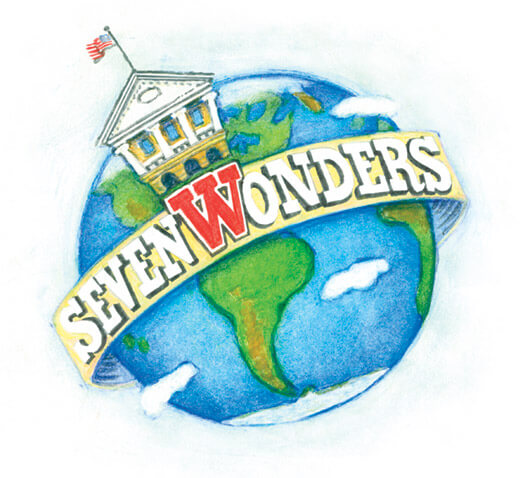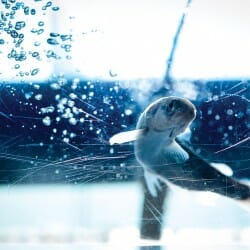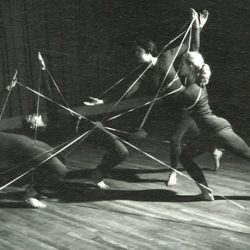Seven Wonders
An admittedly arbitrary list of discoveries from the UW that changed the world for good.
UW-Madison is fertile ground
for imagination and innovation. Our best and brightest make discoveries that change lives — and sometimes save them. And we’re not just talking about Babcock Hall’s orange custard chocolate chip ice cream.
This tradition is poised to continue with the opening of the Wisconsin Institutes for Discovery on campus in December. We at On Wisconsin admit that we don’t always understand the full significance of exciting research findings that seem to emerge from campus nearly every day and make us wish that we’d paid closer attention in science class. But we do know that the UW is a source of life-changing work.
To get a sense of what we have to look forward to, we looked back. Be forewarned: this list is not exhaustive. In fact, it’s entirely arbitrary, and we expect that many of you would like to add to the seven discoveries we picked.
No one can dispute this, however: these are seven homegrown finds that make a tangible difference outside of the classroom, the library, and the laboratory.
At the very least, pull them out of your back pocket the next time you want to brag about the UW. It never hurts to be ready in case you’re stuck at a party with someone who extols the virtues of a competing alma mater.
Talk among yourselves. Then send us an e-mail at onwisconsin@uwalumni.com if you’d like to add to our list.
Mini Machines
Henry Guckel’s invention wasn’t big, but its potential turned out to be huge.
In 1991, the UW engineering professor made the world’s first working metal micromotor. He used x-ray lithography and electroplating techniques to make the tiny machines, which are smaller than the width of a human hair. When Guckel died in 2000, he held more than eighty patents related to what are now called microelectromechanical systems, or MEMS.
Who uses these microscopic marvels? We all do.
The burgeoning field produced high-speed parts for computers, cars, and airplanes, and even improved medical procedures such as balloon angioplasty to treat heart disease. New applications emerged as researchers applied the existing technology to other devices, ranging from inkjet-printer cartridges to miniature robots and optical scanners.
The latest iPhone has MEMS, including a light sensor and dual microphones for noise cancellation. The devices are also inside instruments for the video game Rock Band, which allows players to try their hand at tunes by groups from the Beatles to Green Day, and part of special suits used to capture movement for animated films (think Avatar).
Making it Compute
Imagine life without the Internet. Yes, there was one.
Without the creativity and foresight of UW computer science researchers, you might not be able to instantaneously look up stats for your fantasy football team, book airline tickets, or find out what guinea pigs eat.
Not everyone thought it was a great idea at first. It took Lawrence Landweber, emeritus professor of computer science, and his team several attempts to get funding to build the Computer Science Network (CSNET) in the early 1980s, linking computer science researchers in university and private settings to one another. Little did the naysayers know that the team’s efforts would help set the stage for the Internet, which today reaches more than one billion people worldwide.
Mold to Medicine
It was the height of World War II. The military needed antibiotics, and lots of them.
While government officials rationed the drugs to give priority to soldiers, UW-Madison joined a massive effort by the U.S. government, scientists, and pharmaceutical manufacturers to ramp up production.
UW researchers J.F. Stauffer PhD’33 and Myron Backus ’28, MA’29, PhD’31 used ultraviolet light to induce thousands of different mutations of a single strain of penicillin mold from a cantaloupe found in a Peoria market. Their work increased the strain’s productivity and paved the way for mass production of antibiotics. All industrial strains used today are descendents of what came from that one moldy melon.
By 1945, every U.S. drugstore had the antibiotic in stock. Anyone who has ever had a sinus infection can appreciate that.
D Spells Research Dollars
With one discovery — that ultraviolet radiation increases the content of vitamin D in food — Harry Steenbock helped set the UW on a course that made other breakthroughs possible.
In 1927, the fledgling Wisconsin Alumni Research Foundation (WARF) executed its very first license agreement. The deal allowed the Quaker Oats Company to use Steenbock’s patented irradiation process to fortify the vitamin D content of breakfast cereals.
Steenbock’s discovery generated $14 million in licensing income in the 1920s and ’30s, helping to fuel additional UW research efforts and establish WARF as a model for protecting intellectual property that has since been copied by more than three hundred other universities.
The innovation doesn’t end there. One of Steenbock’s students, Hector DeLuca MS’53, PhD’55, who today is a UW professor of biochemistry, went on to work with vitamin D and developed treatments for diseases including osteoporosis, vitamin D-dependency rickets, and bone disease due to kidney failure.
The story will likely continue, as new research suggests vitamin D’s power to fight myriad diseases.
A Map that Changed the World
How do you solve a problem like Greenland?
UW geography professor Arthur Robinson MA’38 found a way to fit a spherical globe onto a two-dimensional map in 1963. How? By changing the shape of the world.
The maps sailors used for hundreds of years to navigate the seas distort the size of countries and continents in the Northern Hemisphere. As a result, Greenland appears to be the same size as Africa, even though Africa’s land mass is fourteen times larger.
Robinson, who died in 2004, designed his elliptical-shaped projection to minimize those distortions. When it came to maps, Robinson cared about appearances, and he believed that people wanted to work with maps that were beautiful. He described a competing map projection as “somewhat reminiscent of wet, ragged long winter underwear hung out to dry on the Arctic Circle.”
Others agreed. The National Geographic Society adopted Robinson’s projection, which hangs at the front of classrooms around the world.
Eye in the Sky
The space race had the world looking to the moon in the 1960s, while one UW scientist’s invention gave us a new way to see Earth.
Without Verner Suomi’s spin-scan camera, we might not be able to tune in to The Weather Channel each morning to find out if we should grab an umbrella before leaving home.
Suomi founded the UW’s renowned Space Science and Engineering Center in 1965. In 1966, his camera was on board a NASA satellite launched into orbit — three years before Apollo 11 landed on the moon. The device provided a way to take pictures of Earth from space for the first time by scanning our planet as it spun, snapping sequential pictures at twenty-minute intervals. Suomi’s camera paved the way for what scientists can do today — measure and track cloud and air motion, cloud heights, rainfall, severe weather, pollution, and natural disasters.
No doubt it has also helped people to fill awkward silences in conversation ever since.
History on Tape
It was one of the darkest moments in presidential history, but we didn’t know the whole story until we heard it directly from Richard Nixon.
That’s exactly what he didn’t want. Nixon fought until his death in 1994 to keep private hundreds of hours of secretly recorded conversations. UW historian Stanley Kutler sued and won, forcing the release of the tapes through a deal with Nixon’s estate and the National Archives. In 1996, the archives finally made public all recordings connected to Watergate, which verified Nixon’s knowledge and participation in the cover-up.
“Today, we speak of presidential abuses of power as being ‘worse than Watergate’ in their contempt for lawful processes and the rule of law,” Kutler wrote last year on the thirty-fifth anniversary of Nixon’s resignation. “The ‘lessons’ and meaning of Richard Nixon remain exquisitely relevant.”
Kutler won his battle twenty-one years after Congress first ordered Nixon’s tapes released. He continues to advocate for open government and access to presidential records as a UW emeritus professor of history.
His hard-fought discovery reminds us of one truth that should be self-evident: hide from our history and we’re doomed to repeat it.
Jenny Price ’96 is senior writer for On Wisconsin.
Published in the Winter 2010 issue











Comments
Joseph Tufariello December 7, 2010
I am surprised that the discovery of warfarin (coumadin) by Karl Paul Link was not included in this account. This was an important effort that still is of enormous value to those with certain heart abnormalities.
James December 8, 2010
I’m surprised that most of these seem to be described as so-and-so “paved the way” for something instead of discovering it themselves. Surely you could have come up with a better list of important discoveries here at the UW!
AC December 8, 2010
I completely agree with James. Surprisingly, many discoveries/inventions which were awarded Nobel prize are not mentioned at all. This is particularly bad as the graduate school application/recruitment season is on and I don’t think our prospective students will be very impressed if this how we have “changed the world for good.”
TimH December 9, 2010
Sour grapes, anyone? I totally disagree with Joseph, James, and AC – these are rocking discoveries. Of course there are lots more, but that doesn’t take away from these! Why not point out the additional things discovered at the UW rather than whining?
Joseph Tufariello December 9, 2010
I thought that is what I did Tim.
Sam S December 9, 2010
Please add the contributions of Howard Temin to the growing list. On a different note, I’m discouraged by the imbalance of project investigators. How is it that four out of five funded groups are lead by engineers? We have a diverse selection of experts in many of the sciences. How is it that they lost out to those mostly from one college? Is engineering the new and be all science?